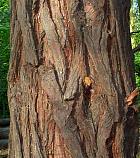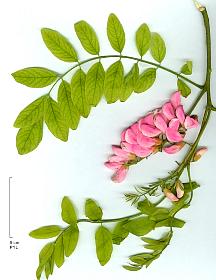Black Locust, False Acacia, Robinia pseudoacacia

Etymology: the french name is "robinier". It comes from its "inventor", Jean Robin, botanist of the king Henry IV who planted it in Paris, on Place Dauphine, in 1600, and transplanted it in the Jardin des Plantes (botanical garden) in 1632. The oldest of Paris are still at the Jardin des Plantes and in the square Saint-Julien-le-pauvre, not far from the cathedral notre-Dame-de-Paris. it was introduced into Britain in 1636.
Origin: United States of America (from Pennsylvania to northern Georgia and westward as far as Arkansas and Oklahoma).
Habiat : it accommodates to poor soils. The black locust has, like most of Fabaceae (formerly Leguminosae), of bacteriorhizes (roots hosting symbiotic bacteria in nodules) that can fix atmospheric nitrogen in the soil. It is a fairly common tree that became encrusted in the city. It is very resistant to pollution.
Hardiness: zone 6 (it supports cold until -23 °C or -9 °F).
Lifespan: 300 years (ordinarily).
Size : 25 m tall.
Form (insulated tree): globular crown.
Trunk: right and often forked, with smooth branches and angular and downy stems, of a ruddy reddish-brown.
Grey bark with dark-brown grey, harsh which cracks in sinuous diagonals. Spines on the stems. Hard wood, orange.
Deciduous foliage. Leaves alternate, big (25 cm) composed of 9 to 21 oval, soft leaflets, squalid green in underside. Leaflets are possibly alternate on both sides of the rachis. It can be confused with Japanese Pagodatree, but their trunks are quite different. The leaflets of Black Locust are round at the end, those of Sophora are sharp. In addition, the leaves of Acacia have stipules at the base of the petiole, which turn into thorns. The leaves may fall still green in the fall, as in other nitrogen-fixing trees (eg alder).
White flowers in long very odorous pendulous clusters, in May-June. The calyx is bell-shaped, green and downy.
Fruits: 8-12 cm pods, in group of two to four, in summer.
Tradition: The Acacia is one of the symbols of the freemasons.
Uses: the Black Locust issues stolons thanks to which the plant spreads, also as it is often used to fix fields threatened with subsidence (dams, platforms) and to reafforest the sterile soils.It colonizes naturally fills, embankments and wastelands. From its sturdy and durable wood, one makes vineyard posts. Triturated, wood produces yellow dye.
The fresh leaves provide interesting fodder in drought years. The leaves have antispasmodic properties.
The sap has a sweet flavor reminiscent of licorice.
Clusters of white flowers are melliferous whence the honey acacia. Rich in nectar, acacia flowers can be eaten in cakes or syrup.
The fragrant flowers are an outlet in perfumery, and are used in the manufacture of perfume and a tonic by maceration for 15 to 20 grams of flowers in one liter of red wine. The flowers contain substances with calming, tonic and astringent.
 Varieties: there is a variety with pink flowers got by hybridization by Decaisne, by 1870, other one with yellow flowers, other one with tortuous stems (Tortuosa).
Varieties: there is a variety with pink flowers got by hybridization by Decaisne, by 1870, other one with yellow flowers, other one with tortuous stems (Tortuosa).
|